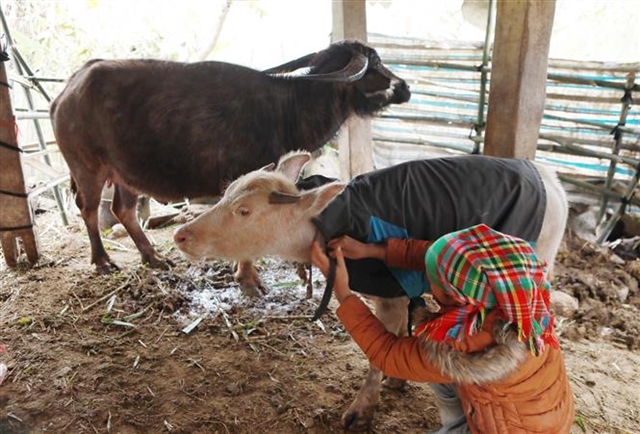 Society
Society

.jpg) |
| Grass covers the road to Bình Quới-Thanh Đa Urban Area in HCM City. The project has been left unfinished and abandoned for three decades. — VNA/VNS Photo Trần Xuân Tình |
HCM City — Nearly 30 years ago, a project to turn the Bình Quới-Thanh Đa peninsula in HCM City into a 427-hectare urban area began.
The Bình Quới-Thanh Đa urban area is located roughly 10 kilometres from downtown HCMC. It was planned to be a modern ecological urban area with an ecological park combining commercial centres and public areas to serve about 80,000 people.
The project was put into the hands of the Sài Gòn Construction Corporation in 2004, but they failed to execute it. It was awarded to a joint venture comprising Bitexco and Emaar Properties PJSC, a Dubai developer, in 2015 at more than VNĐ30 trillion (US$1.28 billion).
After waiting a long time for the land to be transferred, the company pulled out. In the following years, many investors came and left due to complicated compensation procedures for site clearance.
The area has been left abandoned since then. It has become the longest delayed project, with houses deteriorated and roads in bad shape.
Some 3,000 households and 45,000 people live on the peninsula; many struggle to earn their living by farming or raising cows or fish. Most houses are severely degraded but can't be repaired or rebuilt as they are on pending planning land.
The Northwest Urban Area in Hóc Môn and Củ Chi districts is in the same situation. It was meant to become a satellite urban area with an international standard learning and working environment, covering an area of 6,000 hectares in 1998, but has remained on paper for two decades since approval.
Site clearance and compensation have been blamed for the delay. As a result, about 56,000 families in the area have been forced to live in seriously downgraded houses as they can't rebuild or repair them.
According to the city's Department of Natural Resources and Environment, the city has made 11 decisions on revoking and changing land use purposes for 1,445 housing projects. However, only 402 projects have been completed, 741 are underway, and the remaining 302 still need to be implemented.
The city said the main reason for the 302 delayed projects was that they depended on the balance of budget and financial resources of the investors for compensation. In addition, there are difficulties in compensation to affected households.
Lawyer Nguyễn Hữu Thế Trạch of HCM City-based AN PHA NA Law Firm said the pending projects have been creating negative impacts on people's lives and the localities' socio-economic development, making the efficiency of land use almost zero.
The long-delayed projects, which last for decades, have also destroyed the local investment environment.
Director of the city's Department of Natural Resources and Environment, Nguyễn Toàn Thắng, said pending projects remain a difficult problem for the city government.
The department will focus on reviewing and taking action to tackle the pending projects. It has requested the localities to clarify the causes and difficulties of pending projects. He said that for projects that have been removed from the land use plan, there must be a roadmap for planning adjustment so that people can exercise their construction rights.
Bold moves
According to experts, the unclear assignment of responsibilities among departments, sectors and localities, a shortage of policies in auction, compensation, and site clearance and plans on handling projects after revoking from enterprises are among the main cause of the existence of pending projects.
National Assembly deputy Lê Thanh Vân from the NA's Finance and Budget Committee said three main factors have led to projects lagging behind schedule, including planning and getting approval, implementing the project and site clearance. Of that, planning is the key factor.
On July 13, Deputy Prime Minister Lê Văn Thành requested ministries, sectors and local authorities of cities and provinces to coordinate and solve the issue.
The Ministry of Construction and relevant ministries and sectors were asked to focus on perfecting regulations and standards on construction planning and construction investment, including amending and supplementing the Law on Construction, developing the Law on Urban Development Management, the Law on Urban and Rural Planning.
The Ministry of Natural Resources and Environment would require people's committees of localities to inspect and handle projects that failed to put land into use or were slow in land use for one year or more. The results must be reported to the ministry by November 30 before reporting to the Government.
Deputy PM Thành also asked the people's committees to review and cancel the planning that was overdue and unfeasible. Delayed projects must be withdrawn as stipulated, he said.
Under Resolution 18, those who performed land speculation, slow land use, and abandonment of land would be applied a higher tax rate. Those who are allocated or leased land by the State but fail to put it into use or are slow at using it would be sanctioned.
The principle of imposing higher taxes on these activities will make prices more flexible and closer to local realities and solve loopholes for profiteering because of exploiting the current two-price land mechanism.
.jpg) |
| A makeshift house is built on the campus of Bình Quới-Thanh Đa Urban Area. VNA/VNS Photo Trần Xuân Tình |
Vân from the NA's Finance and Budget Committee said localities must be very careful in determining the development framework and consider geographical and natural conditions, population and traffic. Based on that, localities should set up attractive investment and development planning.
The experience of developed countries is to prepare transport infrastructure and education in advance. In regional planning, they always invest in transport infrastructure and education.
"Investors who see good traffic and good intellectual resources will invest. That is the order of priority," he emphasised. — VNS




